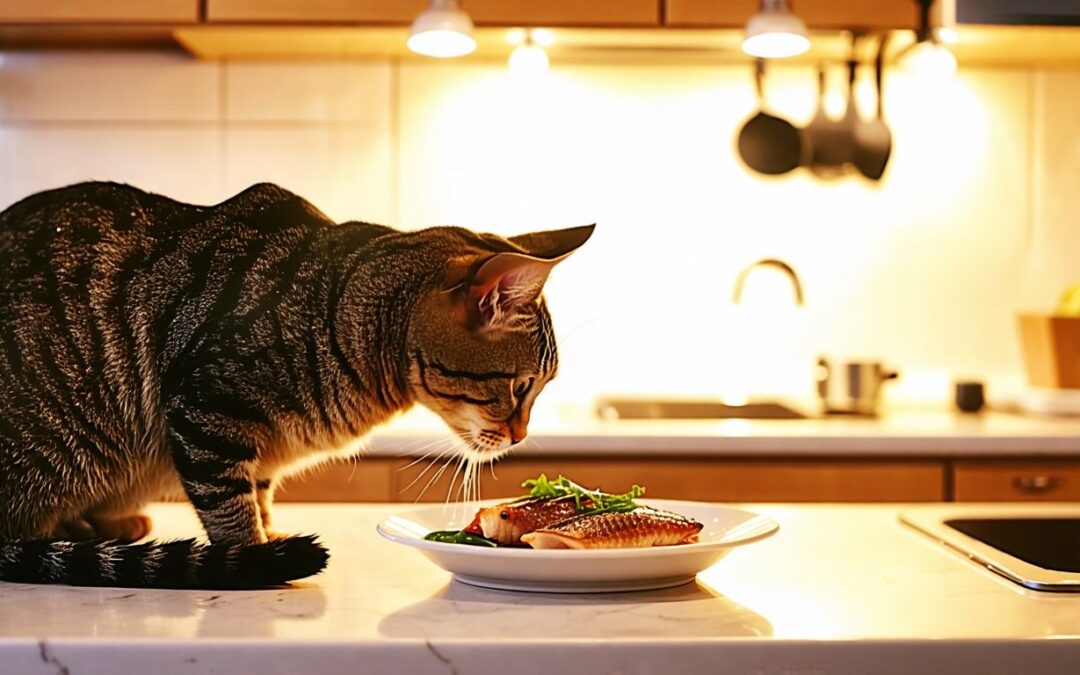Are you wondering if it’s okay to share some tilapia with your furry friend? Tilapia is known for being a great source of protein for cats. Our article will guide you through everything you need to know about including tilapia in your cat’s diet, from nutritional benefits to safety concerns.
Keep reading for all the expert advice!
Key Takeaways
- Tilapia is a rich protein source for cats, providing vital nutrients like omega-3 fatty acids and amino acids that support their health. However, it’s essential to serve it cooked and from high-quality sources to avoid the risks of foodborne illnesses.
- Raw fish, including tilapia, can expose cats to harmful bacteria and parasites leading to serious health issues, so always cook the fish thoroughly before offering it to your cat.
- Seasonings such as lemon pepper should be avoided when preparing tilapia for cats because they cannot digest citrus well and pepper may irritate their stomachs.
- While fish can play a part in fulfilling a cat’s dietary needs for protein, feeding them a variety of safe foods ensures they receive all necessary nutrients. This includes cooked chicken, turkey, specific vegetables, and commercial cat food designed with their nutritional requirements in mind.
- Always consider the amount of protein your cat needs daily (about 40 grams for adults and 45 grams for kittens) when incorporating tilapia into their diet to maintain optimal health.
Can Cats Eat Tilapia? Understanding a Cat’s Nutritional Needs
Cats need a diet rich in protein for strong muscles and overall health. Tilapia can provide some of this protein, but careful consideration is crucial before adding it to their meals.
Protein requirements for cats
Kittens require about 45 grams of protein per day, while adult cats need around 40 grams. Meeting these protein requirements is essential for their growth and overall health. Tilapia is an excellent source of protein for cats, making it a beneficial addition to their diet when fed properly.
Fish like tilapia can provide critical nutrients such as omega-3 fatty acids and various amino acids that support feline health. It’s crucial to consider the quality and safety of fish when feeding it to pets, ensuring that it aligns with their nutritional needs.
Risks of feeding raw fish to pets
Feeding raw fish to pets carries several risks that pet owners should consider. Raw tilapia can expose cats to harmful bacteria and parasites. These pathogens may lead to foodborne illnesses in pets, creating health issues that can be serious.
Cats, in particular, have vulnerable digestive systems when it comes to handling raw foods.
Salmon poisoning has been documented primarily in dogs but highlights the dangers of consuming certain types of fish raw. Even though many fish offer high protein levels beneficial for cat nutrition, sourcing safe options is crucial.
Always ensure that any fish provided is fresh and free from contamination, as this quality directly impacts feline dietary needs and overall cat health.
Tilapia diet for cats
Tilapia can be a beneficial part of a cat’s diet due to its excellent protein content. Cats need about 40 grams of protein daily, and tilapia provides various nutrients like omega-3 fatty acids and essential amino acids.
While cats can safely eat fish, including tilapia, it’s crucial to ensure the fish is cooked properly and sourced from high-quality suppliers to avoid potential health risks.
Many commercial cat foods include fish as an ingredient because it meets their dietary needs. The nutritional requirements for kittens are even higher, reaching 45 grams of protein per day.
Ensuring proper nutrition is vital for feline health, making tilapia a viable option when served in moderation. This sets the stage for understanding whether tilapia is safe for cats by exploring expert advice and associated risks.
Is Tilapia Safe for Cats? Expert Advice and Risks
Tilapia can pose risks for cats, especially when prepared with certain seasonings like lemon pepper. Understanding the dangers of feeding raw fish is crucial to ensuring your pet’s safety and well-being.
Lemon pepper
Lemon pepper is a common seasoning that many people enjoy on their fish dishes. While it adds flavor, cats should avoid it. Cats lack the digestive enzymes to process citrus and may experience gastrointestinal issues if they consume lemon.
Pepper can also irritate a cat’s stomach lining, leading to discomfort or more serious health problems.
Feeding fish to cats can be beneficial if done correctly, but caution is necessary when considering ingredients like lemon pepper. Understanding safe foods for cats helps ensure your feline friend remains healthy while enjoying their meals.
Raw fish dangers for cats
Feeding raw fish, including tilapia, to cats carries certain risks. Raw fish can harbor harmful bacteria and parasites that may lead to foodborne illnesses in pets. These health issues can affect a cat’s digestive system and overall well-being.
Cats are more resilient than some animals, but they are not immune to these dangers. Additionally, certain fish can contain thiaminase, an enzyme that breaks down vitamin B1 in the body.
A deficiency of this vitamin could result in neurological problems for your feline friend.
Cats require a varied diet rich in quality protein to thrive; however, care should be taken when introducing new foods like tilapia into their meals. While it’s true many fish provide excellent protein sources beneficial for a cat’s diet, only cooked or properly prepared options should be considered safe.
Feeding raw tilapia may present unnecessary risks that pet owners need to address before making decisions about their cat’s nutritional needs.
Salmon poisoning in dogs
Salmon poisoning is a serious concern, especially for dogs. It originates from ingesting infected salmon or related fish species. This condition can cause severe gastrointestinal issues and be potentially life-threatening if not treated promptly.
Symptoms may include vomiting, diarrhea, fever, and lethargy in affected pets. While salmon poisoning primarily affects dogs, it’s essential for cat owners to understand the risks of feeding raw fish like tilapia or other types without proper awareness of their sources.
Proper food safety practices are crucial to ensuring pets remain healthy while exploring seafood options.
Foodborne illnesses in pets
Foodborne illnesses in pets can result from contaminated fish. Cats are vulnerable to these risks, especially when consuming raw tilapia or other seafood. Bacteria like Salmonella and Listeria may be present in undercooked or spoiled fish, which can harm your pet’s health.
Symptoms of food poisoning in cats include vomiting, diarrhea, and lethargy. While fish is a common ingredient in commercial cat food and generally safe for feline feeding, it’s essential to consider the source and quality of the fish provided.
Feeding high-quality cooked tilapia reduces the likelihood of introducing harmful pathogens into a cat’s diet while still supporting their nutritional needs.
Can Cats Safely Eat Fish? Important Considerations and Alternative Options
Cats can enjoy fish, but not all types are safe. Consider their nutritional needs and explore other safe food options to keep your feline healthy.
Cat nutrition
Cats require a diet rich in protein to thrive. According to the National Research Council (NRC), kittens need 45 grams of protein per day, while adult cats require about 40 grams. Fish, including tilapia, is an excellent source of this essential nutrient.
It can offer various nutrients such as omega-3 fatty acids and amino acids that contribute positively to a cat’s health.
Feeding fish to cats has become common in many households. While it provides significant benefits for their dietary needs, caution is necessary with certain types of fish and preparations.
Tilapia can be part of a balanced feline diet when served responsibly and sourced from quality providers. Understanding cat dietary restrictions ensures that they receive proper nutrition without unnecessary risks associated with seafood safety.
Safe foods for cats
Fish can be a great addition to a cat’s diet, but not all types are suitable. Always prioritize safety when choosing food for your feline friend.
- Cooked Fish: Cooked tilapia provides a safe protein source and retains essential nutrients like omega-3 fatty acids. Ensure no seasonings or harmful ingredients are added during cooking.
- Canned Fish: Canned fish such as tuna or salmon can be an excellent treat for cats. Check that the fish is packed in water without added salt or sauces, which can be unhealthy.
- Commercial Cat Food: Many brands incorporate fish into their recipes, making them both tasty and nutritious for cats. These foods usually meet specific dietary needs outlined by pet nutrition experts.
- Chicken: This lean meat serves as a fantastic alternative to high-fat seafood options. It provides ample protein and is often highly palatable for most cats.
- Turkey: Similar to chicken, turkey is another safe option rich in protein for your cat’s diet. Many cats enjoy its flavor and texture.
- Eggs: Cooked eggs are safe and nutritious as they offer high-quality proteins along with essential amino acids critical for cat health.
- Vegetables: Some cooked vegetables like peas, carrots, and squash can safely supplement your cat’s diet with extra vitamins while adding variety to their meals.
- Rice: Plain, cooked rice can serve as filler food if you need to balance your cat’s diet occasionally. It offers carbohydrates but should not replace proper nutrition needs from animal proteins.
- Fruits: Certain fruits like blueberries and melons are safe in small amounts and provide hydration along with antioxidants beneficial for overall well-being.
Offering diverse yet safe foods ensures balanced nutrition while keeping your cat satisfied with their meals.
Feline diet
A balanced feline diet is crucial for a cat’s health. Kittens require 45 grams of protein daily, while adult cats need about 40 grams. Tilapia serves as an excellent source of protein, providing essential amino acids and nutrients like omega-3 fatty acids beneficial for their overall well-being.
Many commercial cat foods include fish as a key ingredient, acknowledging the importance of this dietary component in satisfying a cat’s nutritional needs.
Cats can eat various types of fish safely; however, it’s vital to consider the quality and source before feeding them tilapia or any seafood. Feeding fish to cats remains a debated topic among pet owners and veterinarians alike due to potential risks associated with raw fish consumption.
Proper care ensures that your feline companion enjoys the benefits seafood can offer without unnecessary health concerns.
Conclusion: The Importance of Moderation in Feeding Tilapia to Cats
Feeding tilapia to your cat can be a tasty treat and a good source of protein. Ensure you choose high-quality fish from reliable sources. Moderation is key; too much fish can lead to health issues.
Always cook the tilapia properly to avoid any risks associated with raw fish. Keep your feline friend healthy by balancing their diet with other essential nutrients!
FAQs
1. Can cats eat tilapia?
Yes, cats can eat tilapia. It’s a type of fish that could be included in cat food but it should be prepared safely to meet the dietary needs of your cat.
2. What are the safety measures when feeding seafood like tilapia to my cat?
When preparing seafood such as tilapia for your cat, make sure it is fully cooked and free from bones or seasoning which may harm them.
3. Is fish a good choice for regular cat food?
Fish like Tilapia can provide essential nutrients for cats but shouldn’t form the main part of their diet due to potential health risks if consumed excessively.
4. How does eating tilapia affect my cat’s care routine?
Including carefully prepared Tilapia in your pet’s meals could add variety to their diet; however, remember that overall balanced nutrition is key in effective Cat Care.






